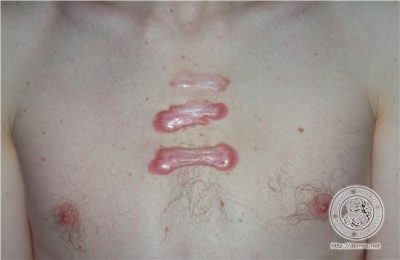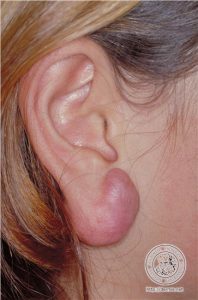SERVICES
- Allergy Screening
- Chemical Peels
- Dermapen
- Facial Skin Analysis
- FreshEyes
- Hyperhidrosis (Excessive Sweating)
- Hair Loss Treatment
- Laser Clinic
- Liquid Facelift
- Keloid Treatments
- Medical Facials
- Medical Treatments
- Mole Mapping
- Photodynamic Therapy (PDT)
- Skincare Advice
- Pigmentation Treatment
- Surgical Procedures
- Ultraviolet Phototherapy
USEFUL LINKS
What is a keloid?
 When a wound heals, it leaves a scar. A keloid is a special type of scar: one that grows too much and can even become larger than the original wound. It is not uncommon for surgical or injury scars to become a little lumpy (hypertrophic). A keloid differs from these in several ways:
When a wound heals, it leaves a scar. A keloid is a special type of scar: one that grows too much and can even become larger than the original wound. It is not uncommon for surgical or injury scars to become a little lumpy (hypertrophic). A keloid differs from these in several ways:
- A keloid can come up after very minor skin damage, such as an acne spot, or even if there has been no obvious damage to the skin at all.
- It can spread outside the original area of skin damage.
- It may last for many years.
Are keloids hereditary?
They can be – a tendency to get keloids certainly runs in some families.
What are the symptoms of a keloid?
Usually there are none; but some are tender, painful, itchy, or cause a burning sensation. The main problem is that their appearance may cause embarrassment. If they are very tight, they can limit movement at nearby joints.
What does a keloid look like?
 Keloids look like exaggerated scars. They are raised above the skin around them and sometimes they are domed. They can extend beyond the limits of the skin damage that caused the scar to come up in the first place. They are shiny and hairless; usually they feel hard and rubbery; and new ones are often red or purple, becoming browner and sometimes paler as they age. Most people with keloids have only one or two. However some people have many, especially if they have come up after acne or chickenpox scars.
Keloids look like exaggerated scars. They are raised above the skin around them and sometimes they are domed. They can extend beyond the limits of the skin damage that caused the scar to come up in the first place. They are shiny and hairless; usually they feel hard and rubbery; and new ones are often red or purple, becoming browner and sometimes paler as they age. Most people with keloids have only one or two. However some people have many, especially if they have come up after acne or chickenpox scars.
How will it be diagnosed?
Your doctor will be able to make the diagnosis of a keloid just by looking at your skin. No investigations are usually needed.
Can a keloid be cured?
It is unusual for a keloid to be cured after treatment. The main problem is that cutting a keloid out often leads to an even bigger one forming later in the same place.
How can a keloid be treated?
Treatment is difficult and not always successful. Possible lines of treatments include the following:
- Injections of a steroid (triamcinolone) into a keloid may help to flatten small early ones.
- Steroid-impregnated tape applied for 12 hours a day may help to flatten keloids.
- Freezing with liquid nitrogen may also stop early keloids from growing.
- Putting a silicone sheet over them at night for several months helps some keloids to flatten. Long-term compression with pressure bandages sometimes helps too
- .Laser treatment makes keloids less red, but does not make them smaller.
- If a keloid is cut out, it usually comes back, and may end up larger than it was before. This risk falls if the area is treated after the operation with pressure dressings or local steroid injections.
What can I do?
With keloids, prevention is better than cure. You have an extra risk of getting a keloid if:
- You have had a keloid before.
- Members of your family have had them.
- You have a dark skin.
If you are at risk, you should avoid, tattoos or body piercing, particularly if these would go through one of the high-risk areas of skin, such as the ear lobes. If you have acne, see your doctor to make sure it is treated vigorously to limit the risk of scarring. You should avoid having skin surgery for cosmetic purposes.
Patient Testimonials
EXCELLENTTrustindex verifies that the original source of the review is Google. From my first visit with Dr Jhetam I knew I would go back. He is compassionate , friendly and has an interaction which made you feel comfortable. This is very important in any doctor because our relationship with our doctor is very intimate.Posted onTrustindex verifies that the original source of the review is Google. Dr Jhetman is truly one of a kind. Anyone who is fortunate enough to be in his care can so grateful. Academic, informative and reassuring. It’s hard to find a doctor who has this combination of skills these days. He dealt with my Melonoma concerns with swift and professional care. And his staff are equally as competent and caring. I cannot commend Dr Jhetman and his staff enough on true patient care. Thank you!Posted onTrustindex verifies that the original source of the review is Google. I was absolutely satisfied with my experience with Dr Jhetham & his winning team. Keep up the good work.Posted onTrustindex verifies that the original source of the review is Google. Best skin doctor..Dr Jetham prescribed the best products that have brought so much of a glow to my skin..being a transplant patient and so much happening to my skin just 4 visits to him and my face is back to it's radiance ..I hightly reccomend Dr Jetham ...you won't go wrong..Posted onTrustindex verifies that the original source of the review is Google. Dr. Imraan Jhetam and his team provided exceptional care, showcasing professionalism and compassion in every interaction. Dr. Jhetam took the time to thoroughly explain everything, addressing each of my concerns with empathy and understanding. My experience with him was truly wonderful, and I highly appreciate his dedication to patient care.Verified by TrustindexTrustindex verified badge is the Universal Symbol of Trust. Only the greatest companies can get the verified badge who has a review score above 4.5, based on customer reviews over the past 12 months. Read more



